
Just after dawn on New Year’s Day, a catastrophic fire broke out in the “Little Mogadishu” district of Minneapolis. The blaze began when an explosion blew out the windows in an upstairs apartment, propelling window frames and plywood debris into the street. The resulting fire sent flames twenty feet above the roof and took two days to extinguish. The bodies of two victims were found in the burned-out building, and a third man died later in the hospital.
News about the fire and explosion appeared briefly in the national media, and reporting on the incident continued through Friday in the local Twin Cities outlets. It faded over that weekend, and the story never really resumed the following week. Since that time it has all but disappeared. The two most recent media items were an announcement that a benefit will be held for the victims of the fire on January 24, and a report that four of the victims remain hospitalized.
The latter article makes this laughable assertion:
The cause of the fire that destroyed the Otanga grocery and displaced residents from the apartment above remains under investigation.
The cause of the fire is not being investigated, because it can’t be investigated: all the meaningful evidence was destroyed when the fire-damaged building was demolished less than seventy-two hours after the explosion occurred.
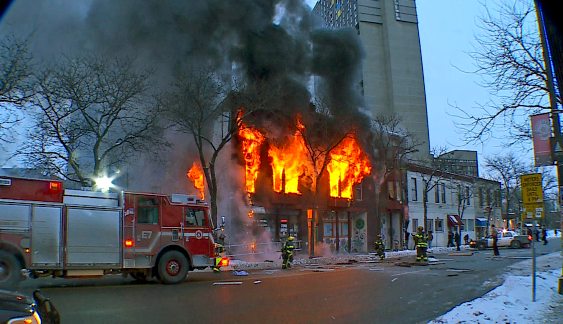
I’ve been following the news of this incident since shortly after the explosion, and I’m forced to conclude that some or all of the following crimes were committed, and are still being committed. There may be others; I’m not a legal expert:
- Official malfeasance
- Dereliction of duty
- Obstruction of justice
- Destruction of evidence
- Misprision of multiple felonies
- Conspiracy
It’s hard to determine who might be guilty of these offenses, but the list of suspects moves beyond Minneapolis city officials and up into the rarefied region inhabited by agencies of the federal government, including the Department of Homeland Security and the FBI.
These crimes were committed regardless of what caused the explosion. Even if the cause of the fire was a natural gas leak, or a malfunctioning propane heater, or an exploding can of deodorant, justice was obstructed and evidence was destroyed. There was a blatant attempt to deflect any meaningful investigation of what did cause the explosion, and the destruction of the relevant evidence ensures that the cause of the fire will never be determined with any certainty.
To recap, here’s what happened that bitterly cold morning in Minneapolis (follow the links at the bottom of this article to find the original news sources):
At 8:16am CT on January 1, 2014, a large explosion shook a three-story building at 514 Cedar Avenue South, in the Cedar-Riverside neighborhood at the western edge of the campus of the University of Minnesota. The structure was quickly engulfed by fire, and some of the apartment-dwellers on the upper floors were forced to jump (or were blown) from their windows into subzero temperatures to escape the blaze. The top floors of the south side of the building eventually collapsed into the first floor. Fourteen people were hospitalized, and one (Abdiqani Adan) later died of his injuries. Two bodies (those of Ahmed Farah Ali and Mrimri Farah, said to be roommates) were eventually found in the rubble.
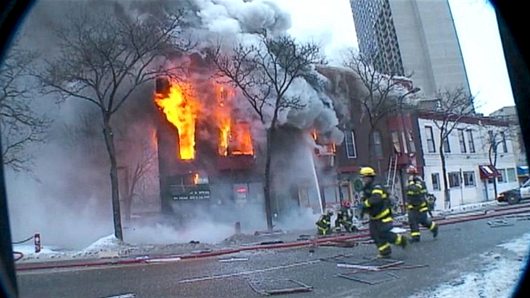
The Minneapolis fire chief (John Fruetel) told the press the cause of the blaze was “not yet known”. This was the official line until the Department of Homeland Security arrived on the scene the following morning, after which the chief said the likely cause was a natural gas leak. He also told the press that “witnesses” reported smelling gas before the explosion, but no such witnesses have come forward to make such statements on the record. All witnesses who have spoken to the press say there was no smell of gas.
The local natural gas utility, CenterPoint Energy, is adamant that there were no gas leaks at that building or anywhere in the area, before, during, or after the explosion.
Chief Fruetel also “ruled out” the possibility that the explosion was caused by a bomb. When the supervisory special agent with the FBI in Minneapolis (Greg Boosalis) spoke to the press, he stated that there was “no evidence of terrorist activity”.
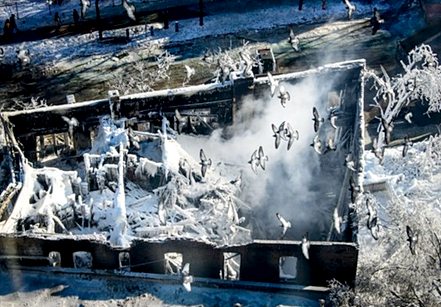
As soon as the fire had been completely extinguished, the city brought in a backhoe to knock down the building. Within seventy-two hours it had been completely demolished, foreclosing any possibility of a thorough forensic examination of the scene.
Next door to and behind the demolished building is a mosque, the “Islamic Civic Society of America and Dar Al-Hijrah Mosque” (imam: Abdisalam Adam). Resources on the links page of the website of the Dar Al-Hijrah Mosque include Tariq Ramadan, Yusuf Al-Qaradawi, the Islamic Circle of North America (ICNA), the Islamic Society of North America (ISNA), the Muslim American Society (MAS), the Council on American-Islamic Relations (CAIR), and the Muslim Brotherhood itself.
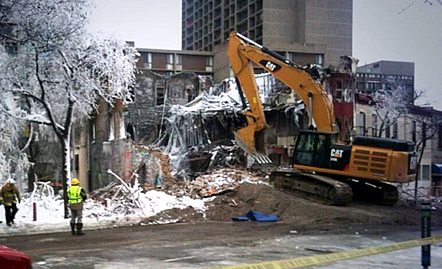
The above description relies solely on the published facts of the case. It does not include any speculation. Here are six pertinent questions prompted by those facts:
| 1. | Why did Chief Fruetel change his statement about the cause of the fire from “unknown” to a “probable natural gas leak” as soon as DHS arrived on the scene? | |
| 2. | What were the names of the alleged witnesses who said they smelled gas? | |
| 3. | Why was a gas leak determined to be the likely cause of the blast before any investigation of the scene had begun? | |
| 4. | How was the fire chief able to rule out a bomb before any investigation had begun? | |
| 5. | What evidence did the FBI use to dismiss the possibility of a terrorist component before any investigation had begun? | |
| 6. | Why was the building at 514 Cedar Avenue South demolished before a forensic examination could be conducted? |
It must be emphasized that everything discussed here is derived from the public record. I have no “inside information”. My conclusions are based on news reports from the media and the phone interviews conducted by Lee Stranahan.
Before moving on to elaboration, speculation, and opinion, I must reiterate the importance of forcing our elected representatives to pay attention to what happened in Minneapolis.
The incident at 514 Cedar Avenue on January 1 has already been all but extinguished by the legacy media — with a few helpful buckets of water thrown on by the federal government. The embers of the story will fade into permanent obscurity unless concerned citizens blow on the coals to keep them alive.
With that end in mind, I urge readers to bring these matters to the attention of the majority members of the House Homeland Security Committee:
- Michael McCaul (Texas), Chairman
- Lamar S. Smith (Texas)
- Peter T. King (New York)
- Mike Rogers (Alabama)
- Paul C. Broun (Georgia)
- Candice S. Miller (Michigan)
- Patrick Meehan (Pennsylvania)
- Jeff Duncan (South Carolina)
- Tom Marino (Pennsylvania)
- Jason Chaffetz (Utah)
- Steven M. Palazzo (Mississippi)
- Lou Barletta (Pennsylvania)
- Richard Hudson (North Carolina)
- Steve Daines (Montana)
- Susan W. Brooks (Indiana)
- Scott Perry (Pennsylvania)
- Mark Sanford (South Carolina)
When you write to a congressman, remember to express your opinions in a polite and reasoned manner. Splenetic outbursts and obscenities will be discarded by aides before their boss ever sees them. Brief, judiciously worded messages — especially those that remind the congressman of his need for re-election later this year — have a better chance of drawing his attention.
If you send a snail-mail message rather than an email, it is less likely to be overlooked and more likely to be read promptly if it is sent to the congressman’s district office, rather than to his office on Capitol Hill. The latter will not receive your letter for months.
Let’s take a look at the wider context of the events in Cedar-Riverside on January 1.
The area is known as “Little Mogadishu” for a good reason: it hosts one of the heaviest concentrations of Somali immigrants in the United States. The Al Qaeda affiliate al-Shabaab is known to recruit among them, and the Twin Cities have sent a significant number of locally-born Somalis back “home” to fight in the jihad.
We’ll assume that the “tiny minority” principle applies here, and that only a small percentage of ethnic Somalis in Minneapolis support or practice “extremism”. For the sake of argument, let’s say it’s no more than 1%. Based on current estimates, that would imply that 1,000 culturally enriched residents of Greater Minneapolis are prepared to fund, plan, or carry out violent jihad attacks at home or abroad.
This calculation alone should have alerted the authorities that the explosion on Cedar Avenue might have involved something more than a natural gas leak. And it certainly should have mitigated against dismissing the possibility of a bomb or “terrorism” even before the rubble had quit smoldering.
But as soon as DHS became involved, that’s exactly what happened. Without conducting any on-the-scene investigation, before any arson investigators or explosives experts could take a close look at the remains of the building, Chief Fruetel ruled out the possibility of a bomb and declared a gas leak as the likely cause. He clung tenaciously to his explanation even in the face of strenuous counter-assertions by the gas utility, saying in effect “That’s my story, and I’m sticking to it.” The FBI backed him up the following morning, blithely poo-pooing the notion that there might have been any terrorist activity involved.
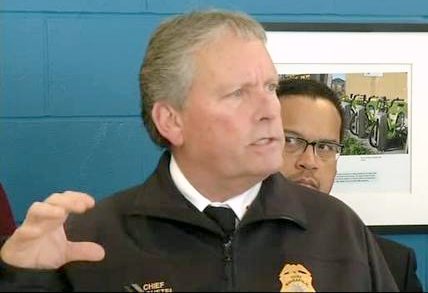
When the fire chief spoke to the press, he was flanked on his right by Abdi Warsame, with Rep. Keith Ellison standing behind him. Mr. Warsame was elected last year to represent the Somali community on the Minneapolis City Council, and Mr. Ellison represents Islam in the House of Representatives. One can’t escape the feeling that less than twenty-four hours after 514 Cedar Avenue went up, the Muslim Brotherhood had sent in its minders to ensure that the fire department and the city government stuck to the designated script.
And the rapid appearance on the scene by DHS — which doesn’t normally rush to the site of every natural gas leak and explosion — tells us that there was more than a ho-hum domestic gas leak involved. Something was definitely up. The hasty declaration that there was nothing to see here, folks, time to move along, should have raised the hackles of suspicion even among the non-paranoid.
But except in the fever swamps of the blogosphere, no one’s hackles were raised. The major news media took their cues from the fire chief and the feds, and smoothly diverted their audience’s attention from the cause of the explosion to the plight of the former residents of the building who were injured, made destitute, and rendered homeless by the fire.
The rapid demolition of the entire structure provoked no media interest. Any investigative reporter worth his shoe leather would have immediately become suspicious, but no one followed up on what happened on January 2 and 3. No hard questions were asked of the relevant authorities at any of the press conferences. And, once the building had become a pile of loose bricks and charred wood, the press conferences stopped.
As Seneca III pointed out in his exhaustive investigation (see Part I, Part IIA, Part IIB, and Part III), the hasty destruction of a potential crime scene runs contrary to all investigative procedure. No administrator who values his job would order such a demolition without a compelling reason — and without being sure that he was immunized against future repercussions for his decision.
The office of fire chief is a political one. It is an absolute certainty that Chief Fruetel would not have ordered the razing of the shell unless he knew there would be no blowback from arson investigators, police detectives, and the FBI. The same is true of the chief of police, the mayor, and any other city officials who may have been involved in the decision.
Presumably the ostensible reason for the demolition was “public safety”. Yet many such damaged structures are left standing until arson specialists can complete their investigations. Insurance companies in particular expect a site to remain intact until the cause of a suspicious fire can be determined — and any fire that begins with a major explosion must surely be labeled “suspicious”.
The area could have been cordoned off and guarded continuously by fire department employees or police officers until the investigators completed their tasks. The roof had collapsed, but the brick shell and much of the interior flooring and walls remained in place. One would expect specialists to shore up the structure and/or send in robots while the evidence was still fresh, to collect samples and photograph the evidence in detail.
But none of this happened. The demolition of the building began immediately, and only halted briefly when the bodies were found and removed. As soon as the imam had been summoned to say a prayer over each tarp-covered corpse, the toppling of the brick walls resumed.
The destruction of the evidence was a clear criminal act. It is absolutely certain that city officials would not have ordered it unless they knew that they would never have to face a court of enquiry for their actions.
Someone higher up in the chain of authority — and possibly all the way at the top of it — must have given the order to bulldoze the evidence, and bulldoze it fast.
There are numerous other fruity aspects to this case, too many to cover thoroughly here. However, the following items and the questions they prompt are worth considering:
| 1. | What’s the story behind the Iraq war vet? Mrimri Farah was one of the two people killed instantly in the explosion. He was reportedly sixty years old when he died, and was alleged to be a former soldier in the U.S. Army who had served in Iraq. Why did a Somali immigrant enlist in the army when he was over forty, and why was he sent to Iraq when he was over fifty? A non-Arab African could hardly be expected to be sufficiently fluent in Iraqi dialects of Arabic (or English, for that matter) to act as an interpreter. What was he doing there? | |
| 2. | The Dar al-Hijrah Mosque, whose structure embraced that of the demolished building, is an unabashed admirer of al-Ikhwan al-Muslimeen, the Muslim Brotherhood, whose affiliates (including CAIR) were designated unindicted co-conspirators in the Holy Land Foundation terror finance trial in 2008. Hamas is the Palestinian franchise of the Ikhwan, which also supports numerous other terrorist outfits. Did local or federal authorities maintain a dossier on any or all activists associated with the Dar al-Hijrah Mosque? Did any of those activists reside in the apartments at 514-510 Cedar Avenue? Were local and federal authorities able to rule out any such connections during the (very few) hours between the explosion and when they declared that the possibility of bombs and “terror” could be discounted? | |
| 3. | An interesting news item was originally published in the Strib and then later removed. Before being cleansed, the original article stated that Basim Sabri is “a property owner who has served as a liaison between authorities and the mosque adjoining the burned building”. But Mr. Sabri is also a convicted felon who served time in prison for bribery. Was the redaction of his involvement simply a discreet airbrush job over seamy politics-as-usual in Minneapolis? Or were there other reasons for his vanishing? | |
| 4. | What happened to the report — which appeared at least once in news accounts, but has since disappeared — about the man who was legless when he was blown from the building? Assuming the story is accurate, is it consistent with injuries that would be expected during a natural gas explosion? | |
| 5. | Who was the unidentified man caught by Google Street View in 2011 relaxing against the side wall of #514 under the surveillance camera? What was his mysterious transaction with another unidentified person? |
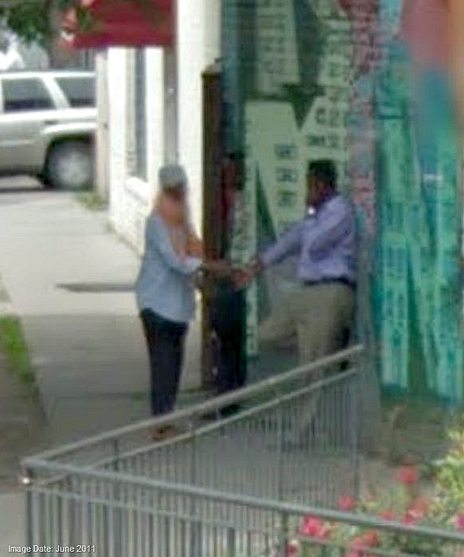
We are unlikely to get answers to these or any other questions about that fiery New Year’s dawn in Minneapolis. The crimes committed that week will only be investigated if concerned citizens raise the matter with their representatives in Congress.
Once again, I urge readers to write to the Republicans on the House Homeland Security Committee and draw their attention to this issue.
Heck, you could even write the Democrats. Or U.S. Senators — for all the good it would do you.

Previous posts about the explosion and fire in Cedar-Riverside, Minneapolis, on New Year’s Day 2014:

To see proper post-fire procedure see Robert De Niro as arson investigator in “Backdraft” (1991.) Forget about razing the structure; it cannot happen except by order from above in unaccountable fascist regimes. Even the Nazis were not brazen enough to tear down the Reichstag after its mysterious destruction by fire on 27 February 1933.
Where would the demolition debris have been taken to? Who hired the CAT? Unfortunately the CAT’s number plate can’t be seen in the photo. If there was a bomb involved, what was the target? A New Year’s Eve celebration, but something went wrong? Would someone have been trying to dismantle a bomb?
It’s pretty clear the DHS knows exactly what caused the explosion, hence the irregular post-fire activities.
I presume there will be a coronial inquiry, as people died?
Firehouse.com: “Minn. Chief, Gas Company Spar Over Cause of Blast”
much more documentation on Basim O. Sabri, property owner in Minneapolis. An émigré himself, Sabri has been living in Minnesota since 1979, when he came to the U.S. to study political science at the University of Minnesota. In December 2004, Sabri was convicted of bribing former Minneapolis City Council Member Brian Herron, who went to prison in 2001 after pleading guilty to extortion. Sabri was sentenced to 33 months for three counts of bribery and left for prison in June 2005. He was released early for good behavior . His wife, Rochelle Barrett, sister and niece ran his business, Sabri Properties, while he was away. 2007 link to tcdailyplanet article w/interesting comments
June 2013. . .via CBSLocal. . .Ex-Mpls. Cop Accused Of Sex Assault Now Working At Mall run/owned by Basim Sabri
cache of page discussing history of Cedar Riverside neighborhood where the explosion took place
More on property developer/ex-con Sabri & wife hiring of police in Minneapolis:
cache of TwinCitiesDailyPlanet, April 2009
Feds investigate Sabri’s brother; The FBI is looking at records related to Azzam Sabri, a brother of convicted developer Basim Sabri. A subpoena seeks information about a Minneapolis development.(2006 NEWS)
****Possibly of interest . . .12/13/2013 Killings prompt questions and worries in Somali community
A comment placed by Bill Gleeson to this article mentions the following:
“As one of my atheist friends likes to say: We’re all God’s children.”
Why would an atheist refer to God? Logical inconsistency….
I think your friend has a great sense of humor
They refer to God only when He seems to toe the ideological line.
Here is a little bit describing the current Cedar Riverside community in relation to Sabri via reddit.com
scroll down a bit more for this:
There’s more worth exploring there.
PostScript: Mayor Betsy Hodges donned a dark blue hijab as she addressed a group of business owners and elders last week at a Somali mall in south Minneapolis.
pic on the page :
http://www.startribune.com/local/minneapolis/254056101.html
3/7/2011, Sabri company fined $5,000 in rupture of gas line
The developer was penalized for digging without first calling to have utility lines marked near Karmel Village. Sabri hasn’t yet paid the penalty, according to the state. He fought it in Hennepin County Conciliation Court, where a judgment was levied against him. The state’s Department of Public Safety is in the process of turning the debt over to state revenue officials for collection, according to department spokeswoman Kristine Chapin. Sabri also ruptured a gas line in 2001 when he was digging with an excavating machine for his shopping strip in the 3000 block of 2nd Avenue S.
I would flag Sabri as a person of interest (POI) in this incident. It would be very interesting to officially interview him just to see what he could be tripped up on. Even taquiyya speakers have their Achilles heel!
Addendum to FIAT LUX Part III, Annex A.
TATP is also an unintended by-product of isomerised safrole, isosafrole, oxidation in acetone which is one of the chemical reaction steps (in certain processes) in the manufacture of MDMA (3,4-methylenedioxy-N-methylamphetamine) a.k.a. ‘Ecstacy’, although I would point out that the level of chemical expertise required for its synthesis is significantly higher than is found in your average jihadi, and furthermore the lab equipment needed is quite sophisticated and expensive.
(MDMA is a controlled substance listed in U.S. Code of Federal Regulations, Title 21, Part 1308.11 (1995) and I am minded of the activity that took place by the side of the building in the original Street View?)
Excellent analysis. In a sane world, GoV would be like Steve Sailer: highly respected and widely influential. The UK has welcomed lots of Somali vibrancy too. Lucky us.
Good work – despite slags of “Conspiracy Theory’s”. Yes, this incident was IMHO suspicious from the very beginning – and I am not even suggesting an attack on/by Islamic factions/sympathizers as might be the case.
What about just good ‘ole Insurance Fraud? Burn down a derelict building and collect the fire insurance? But – as usual – it is the apparent “cover-up” that REALLY causes concern. Who and Why?
We have embarked on a similar (smaller) “Citizen Journalism” investigation of exactly who, why and how a decision to remove the AFDI “Is your family threatening you?” bus ads from Edmonton Transit in Oct 2013.
> A non-Arab African could hardly be expected to be sufficiently fluent in Iraqi dialects of Arabic (or English, for that matter) to act as an interpreter.
My experience teaching English to former translators does not support your assertion: willingness counted more than fluency. You can read about former interpreters on-line if you search on “green card linguist iraq”. But, here you are asking about an enlistee, rather than an Iraqi.
> What was he doing there?
I am not going out on too much of a limb. He was most likey serving his adopted country as a “military linguist,” which is not necessarily an interpreter; getting naturalization papers; and earning whatever $ he could. God rest his soul.
All he would have needed was enough Arabic and English to help out. He also could have gotten into the program because of Somali and other language/cultural skills. Perhaps he was an EMT or other health professional, so the age cut-off was loosened, as it now is to 42 years old at enlistment. Could there be a need for Somali linguists in Iraq? Now, that is an interesting question.
http://www.goarmy.com/content/dam/goarmy/downloaded_assets/mavni/mavni-language.pdf
http://www.defense.gov/news/mavni-fact-sheet.pdf
https://forums.goarmy.com/message/562442 (Oct 1, 2012 9:24 AM)
5. QUALIFICATIONS for MAVNI:
a. Age; 21-40, must be under 40 at the time of shipping except for MOS 09Q.
09Qs boarded for Regular Army appointment must be appointed on Active
Duty prior to their 42nd birthday.
If you glance at linkedin, you’ll find profiles of Somalis who joined the military (perhaps under MAVNI as translators), then continued their service in Iraq.
This job description seems to use a standard template, that may not apply to the particular position description.
http://www.hinklegroup.net/somali-linguist/ Posted on November 22, 2011
* Up to 25% hazardous duty and up to 25% danger pay may be provided to linguists depending o the location they are deployed (i.e. Iraq and Afghanistan).
* Warzone candidates must be willing to commit to a 12 month minimum assignment before they will be considered.
* Candidates must be able to read, comprehend, and translate a major newspaper to include editorials.
* For those accepted for a Warzone assignment, they an expect a 60 day security screening process, after passing the customer language test, prior to becoming a full time employee.
Post benefit concert video report at link:
Comments @ article reveal persistent discontent about investigation
Interestingly, there is another amount listed as being raised for the ‘victims’ of this horrific ‘explosion/fire’ . . .back on January 2nd, 2014 MPR reported:
Another tragic fire destroys a three story structure and takes several lives under horrifically freezing conditions in Quebec. perhaps comparing the investigative process of this fire will provide contrasts in methodology worth exploring:
http://news.yahoo.com/quebec-fire-bodies-search-temporarily-suspended-140736994.html
Another curiosity surfaces post-explosion/fire at Cedar Avenue. . .none of the three reported deceased victims appear to be listed in the Strib’s 1368 obits for the past thirty days. . . . “Abdiqani Adan” , “Ahmed Ali”, nor “Mrimri Farah” appear in the obits under those identities.
If I recall correctly, there is a pattern of this absence on obits for Muslim deceased. With the increase in voter-fraud (deceased casting votes, welfare/SS/food stamp fraud, etc) one cannot help but speculate the worst yet again.
Pingback: Oh, What a Tangled Web We Weave… | Gates of Vienna
No easy relief for fire victims
Some won’t return to work, and others don’t have stable housing yet.
Demolished rubble lies where the Cedar-Riverside building burned on Jan. 1 in Minneapolis, Minn. ByAmanda Snyder
ByNicholas Studenski February 05, 2014
Cedar-Riverside residents are still struggling to readjust after a fire destroyed a building and killed three in the heart of the neighborhood last month.
Fourteen people were injured in the fire the morning of New Year’s Day, seven of whom won’t be able to return to work, said Cheikh Abdi, executive director of the Somali Justice Advocacy Center.
The building housed apartments and a grocery store.
Mohamed Hassan, who lived in the building, was down the street when the fire started, but he lost his friend and roommate.
Hassan was homeless until community organizations recently helped him get an apartment, but he said it’s almost completely unfurnished.
What Hassan wants most, he said, is a TV — or anything to keep him entertained.
“I have no money, no nothing,” he said.
Two fire victims still don’t have a permanent home, Abdi said. Four more are still in a hospital, and two are in a physical rehabilitation center.
Hennepin County is currently providing personal care assistants to those who need them, but Abdi said that the help won’t last forever.
Those physically injured in the fire received medical treatment, he said, but there needs to be a stronger focus on providing psychological help for those affected.
Numerous organizations have supported the recovery, he said, including the Cedar Cultural Center, which held a benefit concert on Jan. 24 to raise money for victims.
Pillsbury United Communities, which operates the Brian Coyle Center, has also started a fund and promised to give all proceeds directly to the victims.
Abdi said the American Red Cross was helpful in providing temporary relief for victims, but some are struggling to settle into permanent housing.
A group of lawyers is working to provide legal aid to those affected, he said.
Abdi said though the fire was likely caused by a gas explosion, fault has not yet been determined.
Because some organizations are still collecting donations, there isn’t a collective total yet. Abdi said he expects and hopes it to be at least $30,000.
The fire itself didn’t damage the mosque next door, Abdi said, but water used to fight the fire caused damage. He said the mosque should eventually be able to return to the building, but the temporary loss of the space has left many with no place to pray.
Abdi said members have held Friday prayers at the nearby Brian Coyle Center. Augsburg College and Trinity Lutheran Church have also offered places to pray.
Hassan said the fire has robbed him and the other victims of their livelihoods, and his goal going forward is to recover what he’s lost the best he can.
Ali Ali, manager at Wadajir Grocery & Halal Meats across the street from where the fire happened, said he’s taken more precautions to keep his business safe, like getting a new fire extinguisher and replacing his smoke alarms.
“It was a wake-up call,” he said. “That could have been me.”
Ali said the fire was particularly sad because those living in the apartment were poor and had a strong impact on the community.
“There’s a lot of sad stories,” he said.
Though the community came together to support the victims, Ali said, he doesn’t think the fire will bring about any major changes.
Ali said he was disappointed that donations became less frequent as media attention dissipated.
“People go back to their business,” he said. “Life goes on.”
Despite the generosity of numerous organizations, Abdi said the recovery is still a work in progress.
“This is not the end of it,” he said.
Minneapolis Law Firm McSweeney / Langevin Representing Victim of Cedar-Riverside Apartment Explosion
Minnesota personal injury law firm McSweeney / Langevin has been retained to represent one of the victims of the Cedar-Riverside Explosion.
Minneapolis, MN (PRWEB) January 31, 2014
The Minneapolis law firm McSweeney / Langevin has been retained to represent one of the fatal victims of the New Year’s Day explosion at the Cedar-Riverside apartment building in Minneapolis. The investigation and litigation is ongoing. (Hennepin County Court File No.: 27-CV-14-400).
McSweeney / Langevin continues to work with investigators to determine the cause of the explosion.
About the Minnesota personal injury law firm of McSweeney / Langevin
With the sole purpose of helping the injured, the personal injury law firm McSweeney / Langevin ensures victims and victims’ families are adequately compensated for wage loss, medical expenses and pain and suffering. The firm handles personal injury cases related to dangerous/defective pharmaceutical drugs, dangerous/defective medical devices, and serious/catastrophic injury claims. McSweeney / Langevin can be reached at 612-746-4646.
PDF Print
Pingback: News links for Feb. 8 2014 – 2 | Vlad Tepes
Pingback: The Big Lie | Gates of Vienna
Pingback: The Al-Shabaab Connection | Gates of Vienna
Pingback: GATES OF VIENNA: THE AL-SHABAAB CONNECTION…….IN MINNEAPOLIS |